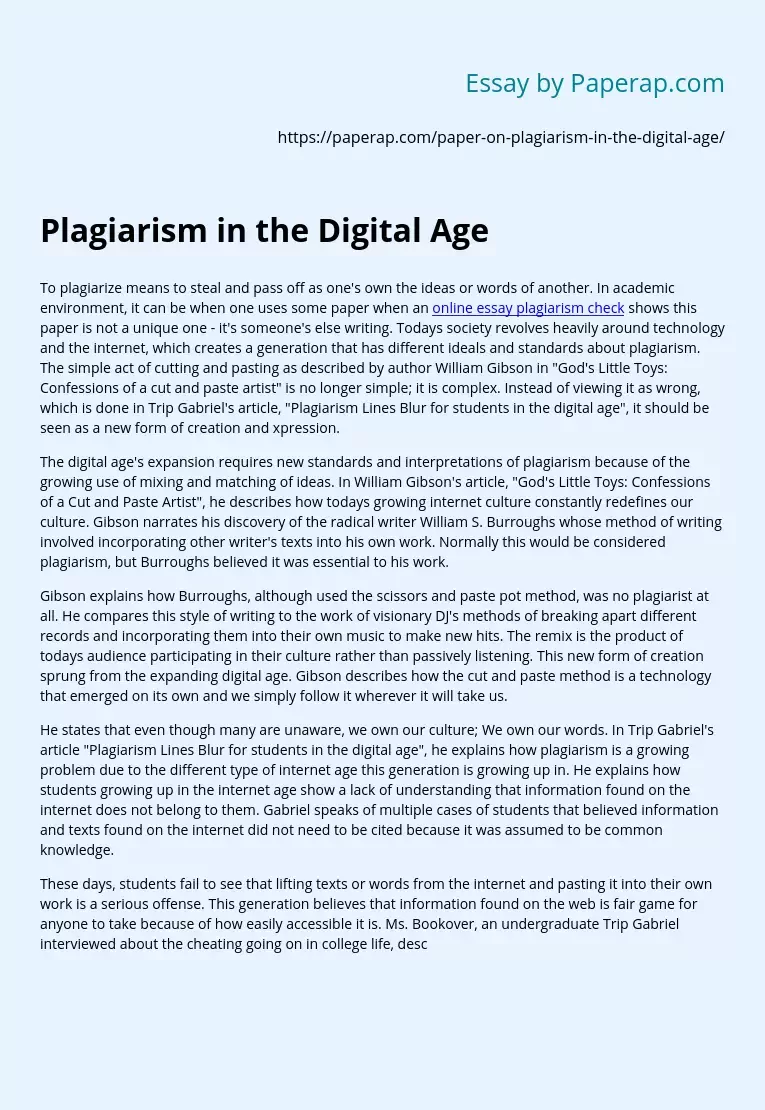Plagiarism in the Digital Age
To plagiarize means to steal and pass off as one’s own the ideas or words of another. In academic environment, it can be when one uses some paper when an online essay plagiarism check shows this paper is not a unique one – it’s someone’s else writing. Todays society revolves heavily around technology and the internet, which creates a generation that has different ideals and standards about plagiarism. The simple act of cutting and pasting as described by author William Gibson in “God’s Little Toys: Confessions of a cut and paste artist” is no longer simple; it is complex.
Instead of viewing it as wrong, which is done in Trip Gabriel’s article, “Plagiarism Lines Blur for students in the digital age”, it should be seen as a new form of creation and xpression.
The digital age’s expansion requires new standards and interpretations of plagiarism because of the growing use of mixing and matching of ideas. In William Gibson’s article, “God’s Little Toys: Confessions of a Cut and Paste Artist”, he describes how todays growing internet culture constantly redefines our culture.
Gibson narrates his discovery of the radical writer William S. Burroughs whose method of writing involved incorporating other writer’s texts into his own work. Normally this would be considered plagiarism, but Burroughs believed it was essential to his work.
Gibson explains how Burroughs, although used the scissors and paste pot method, was no plagiarist at all. He compares this style of writing to the work of visionary DJ’s methods of breaking apart different records and incorporating them into their own music to make new hits.
The remix is the product of todays audience participating in their culture rather than passively listening. This new form of creation sprung from the expanding digital age. Gibson describes how the cut and paste method is a technology that emerged on its own and we simply follow it wherever it will take us.
He states that even though many are unaware, we own our culture; We own our words. In Trip Gabriel’s article “Plagiarism Lines Blur for students in the digital age”, he explains how plagiarism is a growing problem due to the different type of internet age this generation is growing up in. He explains how students growing up in the internet age show a lack of understanding that information found on the internet does not belong to them. Gabriel speaks of multiple cases of students that believed information and texts found on the internet did not need to be cited because it was assumed to be common knowledge.
These days, students fail to see that lifting texts or words from the internet and pasting it into their own work is a serious offense. This generation believes that information found on the web is fair game for anyone to take because of how easily accessible it is. Ms. Bookover, an undergraduate Trip Gabriel interviewed about the cheating going on in college life, describes how walking into a library and actually holding the article is different than viewing it online. Being in the same place one downloads music and video gives the researcher the sense that everything can belong to you.
She discusses how students feel it is O. K. to uses someone else’s words as long as you don’t care and do it purely for a grade. She emphasizes that if the educational system loosens plagiarism standards, creativity will decline and laziness will grow. Bookover believes one major factor for the growth of plagiarism is the lack of preparation and education given in high school In both Gibson and Gabriel’s articles the use of copied texts is discussed, although, both have contrasting opinions on the subject.
Gabriel emphasizes shared texts as being a problem and labels it as plagiarism, whereas Gibson explains how it is a new orm of creating work in an ever changing age of the internet. Gabriel describes a one dimensional evaluation of the topic and Gibson a multi-faceted assessment. Instead of viewing “mixing and matching” as a crime that “does not foster creativity’, it should be seen as more of a way to bring together great ideas that have already been written and creating new works of art (Gabriel).
Just like DJ’s around the world who are “deconstructing recorded music” to create their own “versions”, writers who use the idea’s of others create their own (Gibson). Applying the same methods, riters use an endless “recombinant” process that actively uses ideas from past work as a Jumping off point and expand upon them (Gibson). This characteristic of todays digital media age should not be frowned on by the academic community, but rather viewed with an open mind.
The availability of information on the internet is a useful tool that was meant to be taken advantage of. Students feel confined when they fear the possibility of accidentally using an idea that was not originally theirs, and as a result, stifled creativity. The idea that “students simply do not grasp that using words they did not write is a erious misdeed” is a true statement when blatant copying and pasting of whole paragraphs or essays is concerned, but not so much when ideas or certain texts are taken and used (Gabriel).
Making collages out of previous work should not be put into the same category as mindless copying and pasting because inspiration does not equal plagiarism. The standards defining plagiarism need to be rethought now that todays generation is able to see the endless possibilities and combinations of ideas and information that is open to them. All of the information and all of the ideas in the pool of knowledge belong to the people.
Plagiarism in the Digital Age. (2018, Jun 23). Retrieved from https://paperap.com/paper-on-plagiarism-in-the-digital-age/

